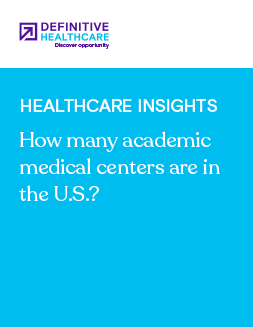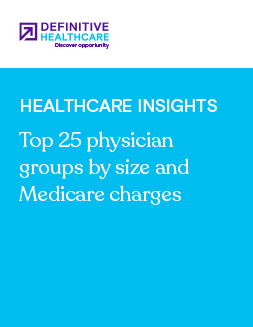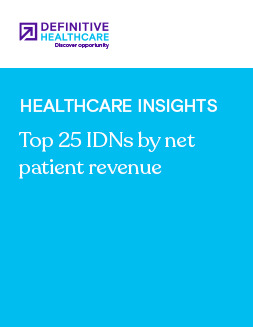Healthcare Insights
Top 50 skilled nursing facilities diagnoses
Skilled nursing facilities (SNFs) play an increasingly important role in the healthcare continuum, particularly as the elderly patient population continues to grow. Definitive Healthcare tracks data on more than 20,000 skilled nursing facilities.
As SNFs frequently provide care to elderly patients and Medicare beneficiaries, we examined the most common diagnoses by both Medicare and commercial claims data.
| Rank | ICD-10 code | ICD-10 description | % of claims | Explore dataset |
|---|---|---|---|---|
| 1 | U071 | COVID-19 | 9.33% | Explore |
| 2 | G9341 | Metabolic encephalopathy | 3.30% | Explore |
| 3 | N390 | Urinary tract infection, site not specified | 2.92% | Explore |
| 4 | Z471 | Aftercare following joint replacement surgery | 1.81% | Explore |
| 5 | A419 | Sepsis, unspecified organism | 1.74% | Explore |
| 6 | J189 | Pneumonia, unspecified organism | 1.73% | Explore |
| 7 | G20 | Parkinson's disease | 1.64% | Explore |
| 8 | Z4789 | Encounter for other orthopedic aftercare | 1.63% | Explore |
| 9 | G9340 | Encephalopathy, unspecified | 1.60% | Explore |
| 10 | J449 | Chronic obstructive pulmonary disease, unspecified | 1.54% | Explore |
| 11 | J9601 | Acute respiratory failure with hypoxia | 1.53% | Explore |
| 12 | I639 | Cerebral infarction, unspecified | 1.49% | Explore |
| 13 | F0390 | Unspecified dementia, unspecified severity, without behavioral disturbance, psychotic disturbance, mood disturbance, and anxiety | 1.07% | Explore |
| 14 | M6259 | Muscle wasting and atrophy, not elsewhere classified, multiple sites | 0.95% | Explore |
| 15 | I69354 | Hemiplegia and hemiparesis following cerebral infarction affecting left non-dominant side | 0.92% | Explore |
| 16 | J441 | Chronic obstructive pulmonary disease with (acute) exacerbation | 0.91% | Explore |
| 17 | N179 | Acute kidney failure, unspecified | 0.87% | Explore |
| 18 | S72002D | Fracture of unspecified part of neck of left femur, subsequent encounter for closed fracture with routine healing | 0.84% | Explore |
| 19 | S72001D | Fracture of unspecified part of neck of right femur, subsequent encounter for closed fracture with routine healing | 0.84% | Explore |
| 20 | I69351 | Hemiplegia and hemiparesis following cerebral infarction affecting right dominant side | 0.83% | Explore |
| 21 | Z48815 | Encounter for surgical aftercare following surgery on the digestive system | 0.82% | Explore |
| 22 | Z4781 | Encounter for orthopedic aftercare following surgical amputation | 0.77% | Explore |
| 23 | S72142D | Displaced intertrochanteric fracture of left femur, subsequent encounter for closed fracture with routine healing | 0.76% | Explore |
| 24 | I509 | Heart failure, unspecified | 0.74% | Explore |
| 25 | R278 | Other lack of coordination | 0.73% | Explore |
| 26 | S72141D | Displaced intertrochanteric fracture of right femur, subsequent encounter for closed fracture with routine healing | 0.71% | Explore |
| 27 | I4891 | Unspecified atrial fibrillation | 0.68% | Explore |
| 28 | I5033 | Acute on chronic diastolic (congestive) heart failure | 0.59% | Explore |
| 29 | J9621 | Acute and chronic respiratory failure with hypoxia | 0.59% | Explore |
| 30 | M6282 | Rhabdomyolysis | 0.58% | Explore |
| 31 | G309 | Alzheimer's disease, unspecified | 0.56% | Explore |
| 32 | N186 | End stage renal disease | 0.54% | Explore |
| 33 | Z48812 | Encounter for surgical aftercare following surgery on the circulatory system | 0.53% | Explore |
| 34 | I214 | Non-ST elevation (NSTEMI) myocardial infarction | 0.52% | Explore |
| 35 | F0391 | Unspecified dementia, unspecified severity, with behavioral disturbance | 0.51% | Explore |
| 36 | E119 | Type 2 diabetes mellitus without complications | 0.47% | Explore |
| 37 | L03115 | Cellulitis of right lower limb | 0.46% | Explore |
| 38 | R55 | Syncope and collapse | 0.46% | Explore |
| 39 | L03116 | Cellulitis of left lower limb | 0.45% | Explore |
| 40 | I6930 | Unspecified sequelae of cerebral infarction | 0.42% | Explore |
| 41 | G35 | Multiple sclerosis | 0.42% | Explore |
| 42 | I2510 | Atherosclerotic heart disease of native coronary artery without angina pectoris | 0.40% | Explore |
| 43 | I5023 | Acute on chronic systolic (congestive) heart failure | 0.38% | Explore |
| 44 | I480 | Paroxysmal atrial fibrillation | 0.37% | Explore |
| 45 | J690 | Pneumonitis due to inhalation of food and vomit | 0.36% | Explore |
| 46 | D649 | Anemia, unspecified | 0.36% | Explore |
| 47 | I69398 | Other sequelae of cerebral infarction | 0.31% | Explore |
| 48 | S065X0D | Traumatic subdural hemorrhage without loss of consciousness, subsequent encounter | 0.31% | Explore |
| 49 | S7291XD | Unspecified fracture of right femur, subsequent encounter for closed fracture with routine healing | 0.30% | Explore |
| 50 | E871 | Hypo-osmolality and hyponatremia | 0.29% | Explore |
Fig. 1 Claims data is sourced from medical claims clearinghouses in the United States. Data is accurate as of October 2023.
What are the most common skilled nursing facility diagnoses?
The most common diagnosis in skilled nursing facilities is COVID-19, representing 9.33% of all SNF diagnosis claims filed. Long-term care facilities like SNFs were hit particularly hard at the start of the pandemic. As the SNF patient population tends to be elderly, most patients fall into the high-risk category for COVID-19.
Next on our list is metabolic encephalopathy, with 3.30% of SNF claims. Metabolic encephalopathies are a series of neurological disorders caused by chronic illnesses like heart disease, diabetes, and renal and respiratory failure. As our data demonstrates, patients with these conditions represent a considerable portion of SNF claims.
Urinary tract infections are the third most common diagnosis in SNFs, with 2.92% of claims. Urinary tract infections are not only among the most common infections in nursing homes, but they’re also among the most prevalent healthcare-acquired conditions.
Other common diagnoses at SNFs include respiratory illnesses such as pneumonia and COPD, neurological disorders such as dementia, and a variety of orthopedic conditions.
What is a skilled nursing facility (SNF)?
A skilled nursing facility is an inpatient facility that provides short- or long-term rehabilitation services. These facilities provide 24-hour licensed medical support to patients requiring transitional care following a qualifying hospital stay for illness, injury, or surgery.
The facilities primarily serve elderly patients and the majority of SNFs are Medicare-certified. Medicare beneficiaries are covered for up to 100 days in a SNF and face out-of-pocket costs for each additional day they spend in SNF care.
What qualifies a patient for skilled nursing care?
Patients who require skilled rehabilitative therapy or skilled nursing care typically qualify for a set number of days of skilled nursing care.
Under Medicare, beneficiaries are covered for SNF care if:
- They have Medicare Part A and have days left in their benefit period available for use.
- They were formally admitted to inpatient care at a hospital for three consecutive days.
- They entered a Medicare-certified SNF within 30 days of leaving the hospital and receiving care for the same condition they were treated for during their hospital stay.
- Their doctor has decided they required daily skilled care that needs to be received from, or under the supervision of skilled nursing or therapy staff.
Patients who required skilled nursing care can typically receive the following services at SNF facilities:
- Medication management
- Assistance with daily living activities
- Meal preparation and dietary counseling
- Wound care
- Physical, occupational, and/or speech therapy
- Cardiac rehabilitation
- Post-stroke rehabilitation
What is the difference between a skilled nursing facility, assisted living, and a nursing home?
The biggest difference between skilled nursing facilities and assisted living facilities is that SNFs provide medical care while assisted living facilities provide more personal care in a home-like, social setting. Residents in an assisted living facility may only need moderate amounts of clinical care whereas those in skilled nursing require 24/7 care or rehabilitation services.
Skilled nursing facilities and nursing homes differ in that a nursing home tends to serve as a permanent residence for people who need long-term 24/7 care. SNFs are temporary residences for patients undergoing necessary rehabilitation or skilled nursing care, typically after a hospital stay, with a limited timeframe for care.
Learn more
Healthcare Insights are developed with healthcare commercial intelligence from the Definitive Healthcare platform. Want even more insights? Start a free trial now and get access to the latest healthcare commercial intelligence on hospitals, physicians, and other healthcare providers.


